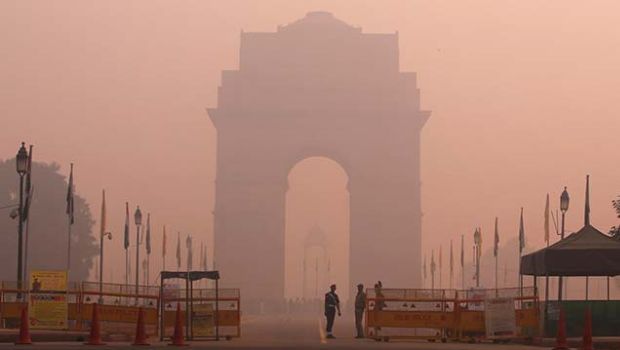With pollution levels rising in both New Delhi and Mumbai, the Central Pollution Control Board is set to implement an emergency action plan to combat the situation. The emergency plan is likely to implement stringent actions against stubble burning, regular water sprinkling in open areas, ban on diesel vehicles etc.
Here is everything you should know about the emergency plan and how it may affect you:
- Starting today, measures that have been implemented to improve air quality in Delhi include ban on garbage burning, mechanised sweeping of roads, impounding of polluting vehicles and deploying traffic police for smooth flow of traffic at vulnerable points.
- Currently, the air quality in Delhi is ‘poor’ and only moderate measures are put in place, but authorities have predicted that it would reach the ‘very poor’ category in the next couple of days.
- If the air quality gets worsen and moves into ‘very poor’ and ‘severe category’, other stringent measures like ban on construction activities, hike in parking fees, roll out of odd-even vehicle scheme will be implemented.
- If air quality lies in moderate to poor category- measures, like stopping garbage burning in landfills and other places, and enforcing all pollution control regulations in brick kilns and industries, would be implemented.
- If it falls to severe level, steps like increasing frequency of mechanised cleaning of roads, sprinkling of water on roads and identifying road stretches with high dust generation.
- Under severe plus emergency category, entry of trucks into Delhi will be banned, construction activities will be stopped and a task force will be appointed to take decision on any additional steps, including shutting of schools.
- Satellite images from the NASA have showed rampant stubble-burning” activity in Punjab and Haryana.
- Burning of crop residue in Punjab and Haryana has increased significantly over the past 10 days .
- Burning of paddy straw every year during October and November and wheat straw during April in Punjab and Haryana are the major contributors of air pollution in Delhi-NCR, as the smoke travels towards the national capital. In Delhi, it mixes with the fog and creates a toxic smoggy winter every year.
What has the government done to prevent air pollution over the year?
Here’s the Ministry of Environment’s response:
- Stringent BS–IV vehicle norms have been implemented from April 1, 2017 throughout the country. Leapfrogging to BS-VI fuel standards from 1st April, 2018 has been done in Delhi. BS–VI vehicle norms are proposed to be implemented from April, 2020 across the country.
- Standards for SO2 & NOx have been revised this year for five Industrial sectors and for all types of industrial boilers using solid and liquid fuels.
- National Clean Air Programme (NCAP) was set to be launched by the environment ministry for controlling air pollution. However, NCAP proposal is still in draft.
- 31 point action plan for prevention, control or abatement of air pollution and improvement of ambient air quality in non-attainment cities and towns has been issued to concerned State Pollution Control Boards. Further, to sensitise stakeholders such as local urban bodies, transport departments, industries, pollution control boards, etc. and facilitate preparation of action plans, six regional workshops at Bhubaneshwar, Bhopal, Chandigarh, Guwahati, Mumbai and Visakhapatnam have been organised.
- Directions have been issued to 6 regions regarding agriculture stubble burning in NCR, Punjab and Haryana to effectively control the air pollution
Environmentalists say govt has failed miserably
Earlier this month, Greenpeace India alleged that the government had failed miserably in staying true to its commitment of notifying a programme which proposes multiple strategies to combat air pollution.
Points highlighted by Greenpeace:
* NCAP still in draft
According to Greenpeace, after much pressure from the public and the media, the Union Environment Ministry in April released the draft NCAP. However, even after five months, there is no sign of the programme being finalised.
* Environment laws weakened
Government is actively diluting environmental laws and arguing on behalf of polluting companies to enable them to continue to pollute.
* Centre, State’s blame game hazardous
Greenpeace said that when asked about the air pollution situation, the Centre and state governments start blaming each other.
* Govt’s favouritism toward polluting firms
Instead of taking action against polluting industries and coal power plants, the government extended deadline for implementation of emissions standards for thermal power plants by another five years.
Why confrontations between farmers and govt continue
Notably, states of Punjab and Haryana every year are blamed for rising air pollution and smog. To avoid stubble burning, the government sanctioned Rs 2.69 billion subsidy to Punjab farmers.
This year, the Centre also announced agricultural mechanisation scheme for in-situ management of crop residue in Punjab, Haryana, western Uttar Pradesh and Delhi with total fund of Rs 11.52 billion for 2018-19 and 2019-20. This year, Punjab will get its share of Rs 2.69 billion to buy 24,972 different machines –rotavator, Happy seeder, chopper, super straw management system—that help in chopping straw in small pieces and spreading them inside the soil itself. However, according to Down To Earth, the scheme was rolled out in April this year, but machines have not reached the cooperative societies.
On October 10, more than 350 farmers protested against the government’s effort to force farmers into buying costly machines to stop burning crop residue. “We demand a proper way of decomposition of straw as machines are not available in any societies,” says Ghuman Singh, state secretary of Bhartiya Kisan Union (BKU), a farmer organisation in the state told Down To Earth. “Even if machines are available, they cannot solve the problem in short time as the time for sowing of wheat and potatoes is approaching,” he adds.
Delhi’s pollution prediction system launched
“The system, first of its kind in the country, was developed indigenously in record time by Indian Institute of Tropical Meteorology, Pune and operationalized by India Meteorological Department (IMD). The system will draw data from 36 monitoring stations run by the Central Pollution Control Board (CPCB), Delhi Pollution Control Committee (DPCC) and SAFAR and will predict a real time information,”
“The system will be devised by mapping of emissions from various sources and analysing quality of meteorological fields in urban areas – be it local air circulation, topographic effect, low winds or breeze conditions in certain months”.


















